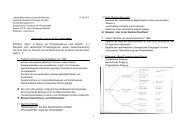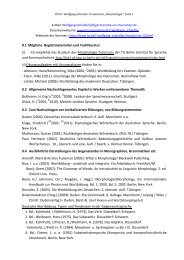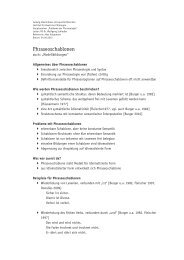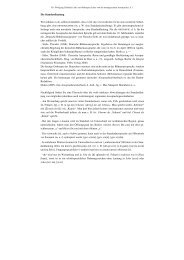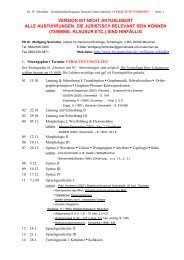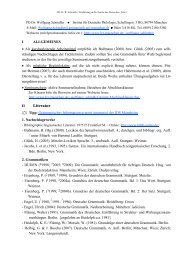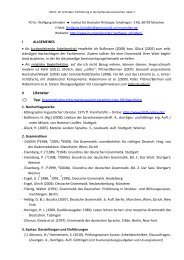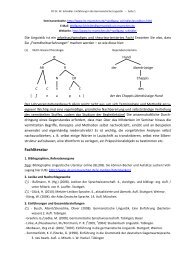Chapter 18 Lexical Functions: Description of Lexical Relations in a ...
Chapter 18 Lexical Functions: Description of Lexical Relations in a ...
Chapter 18 Lexical Functions: Description of Lexical Relations in a ...
Create successful ePaper yourself
Turn your PDF publications into a flip-book with our unique Google optimized e-Paper software.
NB: CausF<strong>in</strong>(P) means—by def<strong>in</strong>ition—Liqu(P).<br />
52-54. Realization verbs<br />
—<strong>Chapter</strong> <strong>18</strong>. <strong>Lexical</strong> <strong>Functions</strong>— 61<br />
The LFs 52-54—Real 0/i, Fact 0/i and Labreal ij, are realization, or fulfillment,<br />
verbs; they mean, very roughly, (fulfill the requirement <strong>of</strong> L) = (do with L what one is supposed<br />
to do with L) or (L fulfills its own requirement). The ‘requirements’ differ with respect to diffe-<br />
rent Ls: thus the ‘requirement’ <strong>of</strong> a hypothesis is its confirmation, the ‘requirement’ <strong>of</strong> a disease<br />
is the malfunction<strong>in</strong>g/death <strong>of</strong> the organism affected, and the ‘requirement’ <strong>of</strong> an artefact is that it<br />
be used accord<strong>in</strong>g to its <strong>in</strong>tended function. Real 0/i [Lat. realis (real)], Fact 0/i [Lat. factum (fait)]<br />
and Labreal ij<br />
[a hybrid <strong>of</strong> Labor and Real] are (more or less) synonymous full verbs, different<br />
with respect to their syntax only; their actants are actantial nouns whose mean<strong>in</strong>g <strong>in</strong>cludes the<br />
component correspond<strong>in</strong>g to a ‘requirement’: (supposed to ...), (designed to ...), etc.<br />
In sharp contrast to the support verbs, which accept as their keywords basically abstract<br />
nouns, the fulfillment verbs can have both abstract and concrete keywords, provided the latter are<br />
actantial and imply a ‘requirement’. Such concrete nouns are necessarily the names <strong>of</strong> artefacts or<br />
organs, which are by def<strong>in</strong>ition (designed to ...).<br />
Syntactically, Real 0/i, Fact 0/i and Labreal ij are fully analogous to the LFs Oper 0/i,<br />
Func 0/i and Labor ij, respectively. This means that the keyword L and its DSyntAs fulfill with<br />
respect to Real i the same syntactic roles as they do with respect to Oper i, etc. Therefore, they are<br />
l<strong>in</strong>ked to their keywords <strong>in</strong> the follow<strong>in</strong>g way:<br />
Real 0/i−II→L, Fact 0/i−I→L, and Labreal ij−III→L.<br />
Examples<br />
Real 1(accusation) = prove [ART ~] Real 2(law) = abide [by ART ~]<br />
Real 1(illness) = succumb [to ART ~] Real 2(demand) = meet [ART ~]<br />
Real 1(car) = drive [ART ~] Real 2(h<strong>in</strong>t) = take [ART ~]<br />
Real 1(bus) = drive [ART ~] Real 2(bus) = ride [(on) ART ~] 19<br />
Compare:<br />
Oper 1(obstacle) = face [ART ~], but Real 1(obstacle) = //turn back<br />
Oper 2(attack) = be [under ART ~], but Real 2(attack) = fall [to ART ~ →<strong>of</strong> NX]<br />
Oper 2(exam) = take [ART ~], sit [<strong>in</strong> ART ~], but Real 2(exam) = pass [ART ~]<br />
Fact 0(hope N ) = comes true Fact 0(film N ) = is play<strong>in</strong>g, is on<br />
Rus. Fact 0(nadežda (hopeN)) = opravdyvaetsja Fact 0(podozrenie (suspicion)) = podtverž-



![E-Mail: Wolfgang.Schindler[ätt]germanistik.uni-muenchen.de Web ...](https://img.yumpu.com/51590147/1/184x260/e-mail-wolfgangschindlerattgermanistikuni-muenchende-web-.jpg?quality=85)
